How Much Does It Cost to Upload Cw
Introduction:
Semiconductor laser diodes range widely in cost based on a few key parameters. The wavelength, power, spectral qualities, parcel type, crenel type and quantity will all have an effect on the price. You can buy a laser diode for less than a dollar. But the price tin also be in the tens of thousands of dollars just by changing several paramaters. This summary is to help you better understand how your awarding requirements may affect the overall price.
How does the wavelength affect the price of a light amplification by stimulated emission of radiation diode?
Wavelengths that autumn into the category of high volume consumer applications such as consumer electronics or telecommunications applications will be significantly less expense than devices that don't reap the benefites of loftier book economies of calibration. Wavelengths for consumer electronics include carmine laser diodes in the 630nm to 670nm range that are used in optical mice, levelers or for laser pointers. Another loftier book market is telecommunications lasers including near IR pump lasers for amplifiers and 113XXnm ~ 15XXnm for communications signals. The graph beneath should give you a basic understanding of popular wavelengths and what the toll will be of the laser diode.
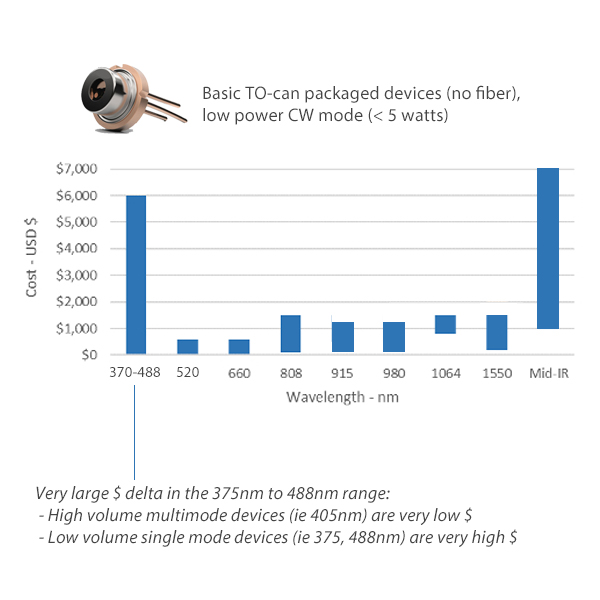
Price Range: A Graph of Laser Diode Price Ranges past Wavelength
Why such a large price range at 405nm? While low cost 405nm blue light amplification by stimulated emission of radiation diodes are available that are manufactured for high volume applications, there are many specialty narrow linewidth and/or unmarried style 375nm ~ 488nm lasers that are used in biomedical imaging and flourescence applications. The spectral backdrop of these devices control a very loftier toll. The cost ranges presented above also take into consideration the output ability. As a rule of pollex the higher the output power, the higher the price. But this rule does not always apply when y'all are shopping for different package styles, single transverse mode or other specific spectral requirements.
How do the spectral backdrop impact the price?
Not sure what we hateful by the term spectral or how a light amplification by stimulated emission of radiation diode works; see this article titled An Introduction to Light amplification by stimulated emission of radiation Diodes. Spectral line width is sometimes specified in frequency, and sometimes in nanometers. But not all manufacturers volition specify this and it is only typically found on data sheets for DFB laser diodes, DBR'south, ECL's, pumps and more narrow linewidth devices.
Fabry-Perot Laser Diodes:
– $ – The well-nigh basic laser diode cavity design and the most affordable applied science. Basically the proceeds medium consists of resonator region spring by 2 parallel partially reflecting mirrors. Some of the calorie-free created in this resonator will be reflected dorsum to the contrary mirror. This will happen until a standard wave is created in the cavity and coherent light is emitted out of the cavity. The optical spectrum doesn't contain one discrete wavelength just features multiple peaks that are close together or ane large wide peak.
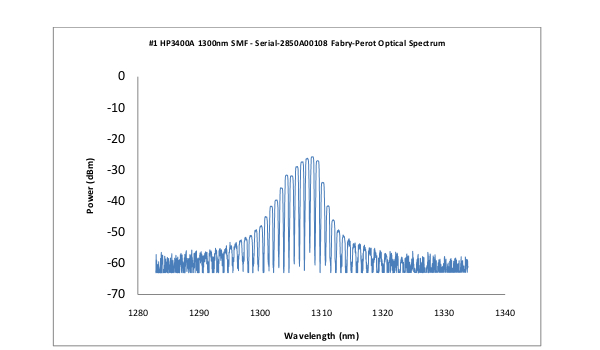
Fabry-Perot laser diode spectrum
DFB, DBR and ECL Single Frequency Light amplification by stimulated emission of radiation Diodes:
– $$$$ – These are more than expensive (oft 3+ times) than basic Fabry-Perot devices. They feature a special structure (grating) in the semiconductor material. A diffraction grating is an optical component with a construction that splits and diffracts light into several beams traveling in dissimilar directions. You can learn more nigh diffraction gratings from University of New South Wales discussion on Diffraction gratings and spectroscopy. This blueprint forces a detached wavelength to exist formed in the light amplification by stimulated emission of radiation cavity which can be observed in the spectrum. This unmarried peak is typical of DFB / DBR lasers and the wavelength can be more hands tuned to a specific frequency. The spectral bandwidth is typically around 2 MHz for well-nigh wavelengths in the 1400nm to 1600nm range. Store for DFB lasers »
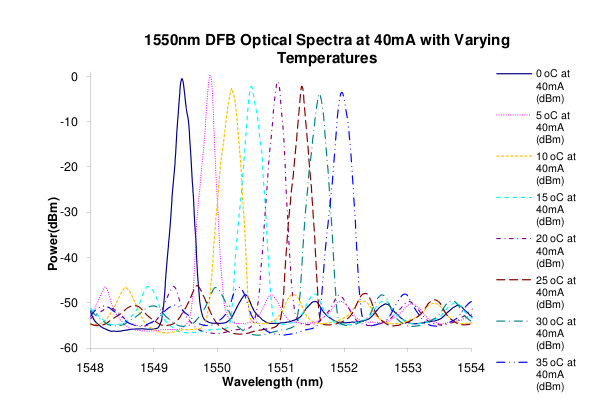
1550nm DFB laser diode spectrum
Narrow Spectral Linewidth Laser Diodes:
– $$$$$ – If you are searching for a 100 to 500 kHz bandwidth 1550nm laser diode, or y'all want a single mode narrow line width 405nm laser diode, the price volition typically be substantially more expensive than a standard Fabry-Perot or even a DFB/DBR. In some cases, these narrow line width lasers will take a more sophisticated grating in the light amplification by stimulated emission of radiation cavity or an external crenel. An external cavity laser still uses a laser diode just in this design the grating that is used in selecting the wavelength is external to the laser bit. This design can produce a more than narrow linewidth than a standard DFB.
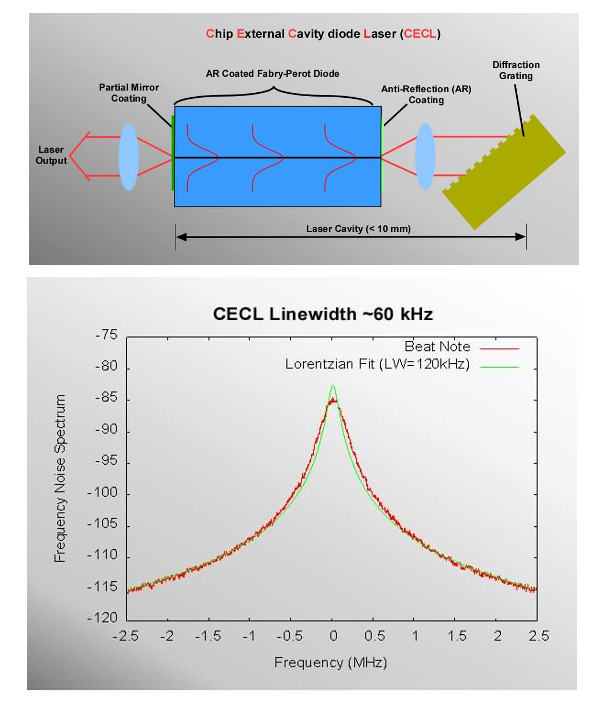
external cavity laser pattern
How does the package type touch price?
Below is a simplification of the nearly common package types. At that place are many variations and not all suppliers provide the diverse packages. Unless you are buying in big quantities (100's – 1000'due south), most manufacturers volition but have their one or two standard packages to cull from. The near common packages for laboratory/R&D employ will be TO-tin for depression power free infinite applications and butterfly for cobweb coupled low power applications. Loftier power is a mix of cobweb coupled multimode modules and various copper mount headers.
Bare Light amplification by stimulated emission of radiation Diode Chips and COC Devices ($10~$500):

Blank diode laser flake
A bare laser diode chip is merely a laser diode flake on a substrate ie aluminum nitride (AlN). This is the most basic commercially available light amplification by stimulated emission of radiation form. Yet, it isn't typically bachelor to a single unit buyer since this is normally designed for volume OEM customers (i.e. someone purchasing 1000's and integrating into other systems). Also this package is difficult to utilize in the lab as it is hard to make electrical connections to the package and heat sinking is tricky.
Open Rut Sink Light amplification by stimulated emission of radiation Diodes (Range is approximately $50 ~ $ane,000):
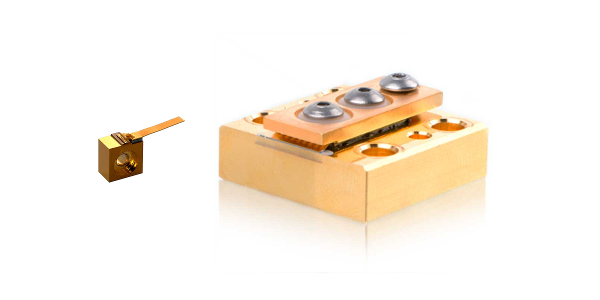
open heat sink laser diode
In an open heat sink type packet, the laser fleck(s) has been mounted onto a metal cake, normally copper, for it'south heat conducting properties. This is a larger package than the bare chip. But in this instance the laser is yet exposed to the atmosphere and then intendance must be taken to not operate in an overly humid environment to avoid condensation damaging the laser bit. The virtually mutual open heat sinks are C-Mounts and CS / CCP packages confined. C-Mounts are typically used for a unmarried light amplification by stimulated emission of radiation scrap with output powers up to x watts. CS / CCP confined contain multiple single laser chips that haven't been singulated (cutting into individual chip-on-substate devices). Blank are used for higher power lasers up to 100+ watts.
TO-Can Packaged (Toll range varies drastically with spectral quality and wavelength: tin be from $15 ~ $6,500):
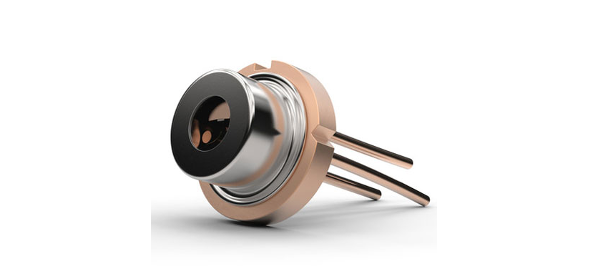
TO-tin packaged light amplification by stimulated emission of radiation diodes
This is the well-nigh common depression-price light amplification by stimulated emission of radiation diode bundle. Typically in a five.6mm or 9mm bore parcel size. The chip is integrated and hermetically sealed into this package and electrical connections are easily fabricated from the leads on the lesser of the package. Most TO-cans feature an integrated photodiode which measures the optical ability from the back facet of the laser diode for constant optical power way or for monitoring the output power. Some TO-Cans feature a cobweb output but they are typically a free space output. In addition some larger TO-cans feature an integrated TEC and thermistor for constant temperature control; however this increases the price.
Butterfly Packaged Light amplification by stimulated emission of radiation Diodes (Range is approximately $600 ~ $4,500):
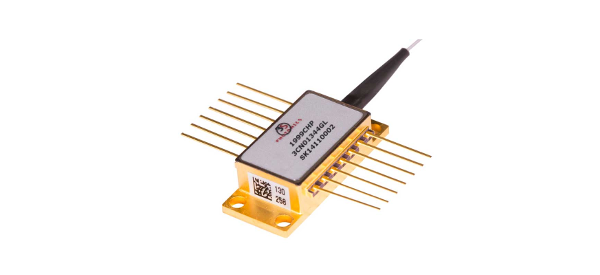
butterfly packaged light amplification by stimulated emission of radiation diode
Butterfly packaged laser diodes are cobweb coupled packages which are very common for spectroscopy, pumping and telecommunications applications. Also the laser diode fleck, the butterfly bundle also incorporates a photodiode, TEC and thermistor for constant optical power operation and stable temperature control. Cobweb output is most common but there are some manufacturers who makes this a free space laser. Electrical connections can easily exist made via common sockets and there are many mounting options available. The butterfly packet is common in the 1550nm wavelength range »


Loftier POWER Laser DIODE PRICES:
Because there is not much price information for high power laser diodes bachelor online, it tin be quite difficult to get a budgetary idea of how much a particular type of device might cost. In gild to help, we put together a short list to help y'all at least figure out how much a "form" of laser diode might price. This listing is a rough guide of pricing past package way and output power for 808, 915, 940, 980nm devices. Delight note that as the output power gets college, the price delta from manufacturer to manufacturer tends to increase profoundly. Information technology'south mutual to get price differences of well over 50% depending on the manufacturer.
Many manufacturers offer two unlike cobweb coupled package types. For lack of industry accepted specific terms, we will refer to 1 as a "basic" fiber coupled module and the second as an "advanced" fiber coupled module. The basic cobweb coupled module is typically a multi-unmarried emitter device (see department in a higher place) with a fixed fiber on the bundle and no connector. It's intended more for book OEM customers that will integrate the laser into their system:
Shop high power laser diodes »
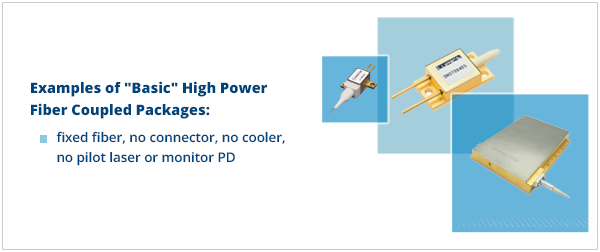
The second package type is an "advanced" module. The avant-garde module is in a larger footprint bundle that includes options such equally integrated cooling, a pilot light amplification by stimulated emission of radiation and a monitor photodiode likewise as other available features. The avant-garde module can business firm a cobweb coupled bar (see section above) or can exist a multi-single chip emitter device. Information technology'due south intended more than for depression book customers who demand the additional module features for their applications:
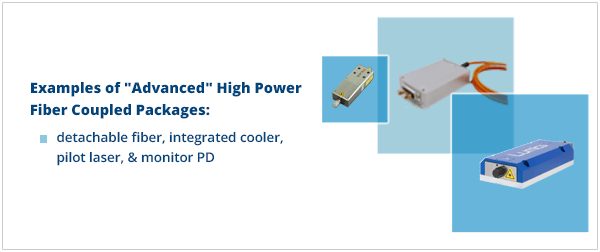
Please note that different most depression ability light amplification by stimulated emission of radiation diodes, prices for comparable loftier power devices volition vary a lot (sometimes past a factor of 2 or more) past manufacturer . This is why the range of prices shown below is large.

5W (CW) Cobweb COUPLED PACKAGES
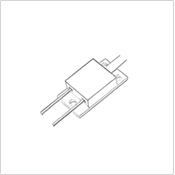
5 Watt "Basic" Fiber Coupled Module:
- $250 to $500
- 808, 915, 940, 980nm / fixed cobweb, no connector
- no cooler, no pilot laser or PD
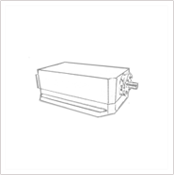
5 Watt "Advanced" Fiber Coupled Module:
- $1,000 to $1,500
- 808, 915, 940, 980nm / detachable cobweb
- integrated cooler, pilot laser, & monitor PD

10W (CW) Fiber COUPLED PACKAGES

10 Watt "Basic" Fiber Coupled Module:
- $350 to $600
- 808, 915, 940, 980nm / stock-still fiber, no connector
- no cooler, no pilot light amplification by stimulated emission of radiation or PD

10 Watt "Advanced" Fiber Coupled Module:
- $1,500 to $two,000
- 808, 915, 940, 980nm / detachable cobweb
- integrated cooler, airplane pilot laser, & monitor PD

50W (CW) Fiber COUPLED PACKAGES
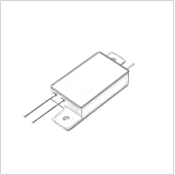
fifty Watt "Bones" Fiber Coupled Module:
- $1,200 to $ane,800
- 808, 915, 940, 980nm / fixed fiber, no connector
- no cooler, no pilot light amplification by stimulated emission of radiation or PD

50 Watt "Advanced" Cobweb Coupled Module:
- $2,000 to $3,000
- 808, 915, 940, 980nm / detachable fiber
- integrated cooler, pilot laser, & monitor PD

80W (CW) BAR / ARRAY
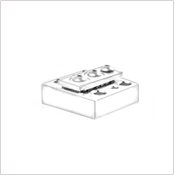
80 Watt Bar / Array:
- $600 to $800
- 808, 915, 940, 980nm / CCS/CP copper bar mount
- no cooler, no eyes

100W (CW) FIBER COUPLED PACKAGES

100 Watt "Basic" Fiber Coupled Module:
- $2,000 to $3,000
- 808, 915, 940, 980nm / fixed fiber, no connector
- no cooler, no pilot laser or PD

100 Watt "Advanced" Cobweb Coupled Module:
- $4500 to $6,000
- 808, 915, 940, 980nm / detachable fiber
- integrated cooler, pilot light amplification by stimulated emission of radiation, & monitor PD

200W (CW) FIBER COUPLED PACKAGES
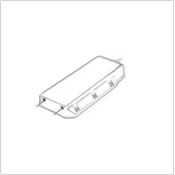
200 Watt "Bones" Fiber Coupled Module:
- $2,500 to $three,500
- 808, 915, 940, 980nm / fixed cobweb, no connector
- no libation, no pilot laser or PD

200 Watt "Advanced" Cobweb Coupled Module:
- $ten,000 to $15,000
- 808, 915, 940, 980nm / detachable fiber
- integrated cooler, pilot light amplification by stimulated emission of radiation, & monitor PD
How does quantity touch price?
For high volume applications like consumer electronics, telecommunications, or cobweb laser pumps it will take buying 100s or 1000s to significantly move the cost. So if yous demand one or 2 lasers at 915nm and x Watts the price will most likely be the same if you purchase only two. At specialty wavelengths used in gas sensing you can see discounts of twenty%-25% just for ordering ii lasers. Equally a general rule the lasers that are manufacturered in loftier volumes will crave larger quantity purchases to receive whatever discounts.
How to narrow in on options:
This is a general overview and should give you guidance for your project. If price is most of import try to select a wavelength from a high volume awarding with a common package. Every bit with all purchasing decisions, the more flexible yous tin can be on your specifications and target price the more likely you can find the perfect laser diode for your application.
Source: https://www.laserdiodesource.com/how-much-does-a-laser-diode-cost
0 Response to "How Much Does It Cost to Upload Cw"
ارسال یک نظر